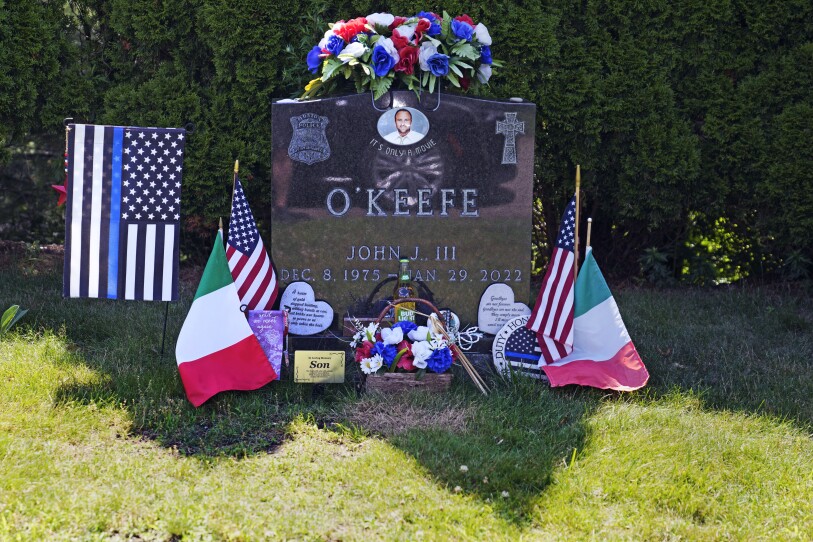A judge declared a mistrial Monday after jurors deadlocked in the case of Karen Read, a woman accused of killing her Boston police officer boyfriend by striking him with her SUV and leaving him in a snowstorm, a case that drew outsize attention thanks to true crime fanatics, conspiracy theorists and Read’s pink-shirted supporters.
Judge Beverly Cannone called for a status hearing on July 22, when the commonwealth is expected to deliver a decision on whether they’d like to try the case again. Prosecutors said in a statement that they intend to retry the case.
Attorney Barry Bisson, who chairs the Massachusetts Bar Association’s Criminal Justice Council, said the prosecution will likely “sit down with the family for awhile” before moving forward.
“It’s unfortunate for both sides, because Ms. Read has to see if the commonwealth is going to try the case again, which could mean another nine-week trial,” Bisson said. “Then you have the victim’s family who would have to sit through this all over again if the commonwealth decides to go through with it.”
The national notoriety of the high-profile case may also inhibit future jury selection, Bisson said.
“No one could say that they haven’t seen or heard about this trial,” he said. “That was the whole thing when they picked the jury the first time, and now it’s been going on for so long, in the news every single day, probably no one in the commonwealth can say that they haven’t heard about this case. That’s probably going to make it even harder to pick a jury next time.”
“No one in the commonwealth can say that they haven’t heard about this case. That’s probably going to make it even harder to pick a jury next time.”
Attorney Barry Bisson
Read, a former adjunct professor at Bentley College, faced second-degree murder and other charges in the death of Officer John O’Keefe, a 16-year member of the Boston police who was found outside a Canton home of another Boston police officer in January 2022. An autopsy found O’Keefe died of hypothermia and blunt force trauma.
Prosecutors said Read and O’Keefe had been drinking heavily before she dropped him off at a party at the home of Brian Albert, a fellow officer. They said she hit him with her SUV before driving away.
The defense sought to portray Read as the victim, saying O’Keefe was actually had been killed inside Albert’s home and then dragged outside and left for dead. They argued that investigators focused on Read because she was a “convenient outsider” who saved them from having to consider other suspects, including Albert and other law enforcement officers at the party.
On Friday, a jury foreperson told the judge that they hadn’t reached a unanimous verdict despite an “exhaustive review of the evidence.” The judge told jurors to keep trying. On Monday morning, jurors said they were at an impasse, but the judge asked them to continue deliberating. In the afternoon, they said it would be futile to continue.
“The deep division is not due to a lack of effort or diligence but rather a sincere adherence to our individual principles or moral convictions,” the jury said in a note read by the judge in court.
O’Keefe’s mother cried after the mistrial was declared, while Read hugged her father and other relatives.
The Norfolk County district attorney’s office said in a statement: “First, we thank the O’Keefe family for their commitment and dedication to this long process. They maintained sight of the true core of this case — to find justice for John O’Keefe. The Commonwealth intends to re-try the case.”
Defense attorney Alan Jackson said he and others representing Read will keep fighting.
“They failed. They failed miserably, and they’ll continue to fail. No matter how long it takes, no matter how long they keep trying, we will not stop fighting,” he told reporters outside court.

Charles Krupa
AP
Testimony during the two-month trial focused on shoddy police work and relationships between the parties. Police acknowledged using red plastic cups to collect blood evidence and a leaf blower to try to clear away snow to reveal evidence. The lead investigator acknowledged making crude statements about Read in texts from his personal cellphone.
Experts disagreed on whether O’Keefe’s injuries were consistent with being hit by Read’s luxury SUV, which had a broken taillight. The defense contended the injuries were caused by an altercation and the Albert family’s aggressive dog.
Prosecutors relied on several first responders who testified that Read admitted that she hit O’Keefe — saying “I hit him” — as well as evidence that Read was legally intoxicated or close to it eight hours later, after she returned to the house with friends and they found the body.
Several witnesses testified the couple had a stormy relationship that had begun to sour. Prosecutors presented angry texts between the couple hours before O’Keefe died. They also played voice messages from Read to O’Keefe that were left after she allegedly struck him, including one left minutes afterward saying, “John I (expletive) hate you.”
Defense attorneys sought to poke holes in the police investigation, noting that Albert’s house was never searched for signs of a fight involving O’Keefe and that the crime scene was not secured. They suggested that some evidence — like pieces of her SUV’s cracked taillight, a broken drinking glass and even a strand of hair — was planted by police.
A turning point in the trial came when lead investigator, State Trooper Michael Proctor, took the stand. He acknowledged sending offensive texts about Read to friends, family and fellow troopers during the investigation. He apologized for the language he used but insisted they had no influence on the investigation.
In his texts, he called Read several names, including “whack job.” At one point, he texted his sister that he wished Read would “kill herself,” which he told jurors was a figure of speech. And despite having relationships with several witnesses, he remained on the case.
Two expert witnesses hired by the U.S. Department of Justice during an investigation of police handling of the case testified for the defense, providing a scientific analysis for their conclusion that O’Keefe’s injuries and the physical evidence didn’t sync with the prosecution theory that he was struck and injured by Read’s 7,000-pound vehicle.
O’Keefe had a significant head injury and other injuries but lacked significant bruising or broken bones typically associated with being hit by a vehicle at the speed indicated by GPS and the SUV’s onboard computer.

Steven Senne
AP
While the drama played out in a courtroom, dozens of Read’s supporters dressed in pink gathered each day outside, carrying “Free Karen Read” signs and mobbing her when she arrived each day. Motorists honked their horns in support. A smaller group of people who want Read convicted also turned up.
Mary McManus, a longtime Canton resident and retired school teacher, used to consider Canton a “sleepy little town.” But she said the case motivated residents to make their voices heard, and once-quiet town meetings transformed into contentious affairs.
“It’s disheartening to know that we have to start this process all over again, but it’s good in a way too, because it’s an eye-opener,” she said. “It’s having the people in town look at what’s going on and taking a more active role in the process.”
Heather Fairfield, a property manager who has lived in Canton for 50 years, says the roughly 24,000-person community has been divided by the “polarizing” case, with many residents afraid to express their opinions out of fear of being ostracized or alienating their neighbors.
She said she was alarmed to hear about how the crime scene was processed by Canton police, who used a leaf blower to remove snow from the scene and collected evidence in red plastic cups and paper bags, according to testimony from Lt. Paul Gallagher of Canton Police.
“The biggest problem we have here, honestly, is that the police broke trust with the community by not doing this investigation properly,” Fairfield said. “And because they broke trust with the people in this town by not doing what they should have done, the people in this town are now breaking trust with each other, because people feel compelled to take sides.”
Suspicions of police corruption following O’Keefe’s death led residents to vote for an independent audit of the police department last November. In January, internal communications confirmed an ongoing federal probe into the Norfolk District Attorney’s office.
The chaos of the case has challenged Canton residents’ trust in authority and police, Fairfield said.
“It’s personal, because I have to live in this town,” she said. “I now have to be afraid that if something happened to one of my loved ones, this is how the investigation is going to be handled, with this level of carelessness.”
GBH News reporter Tori Bedford contributed reaction from attorney Barry Bisson and Canton residents.





